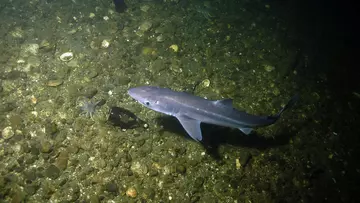
ZSL
Zoological Society of London
We recently launched the first ever State of the Thames report, shining a light on the surprising marine life - like sharks - that lives in the Thames, and the need to continue to protect the species in our waters.
Sharks are part of the UK’s proud natural biodiversity and should fascinate, not terrify.
Last week, we were excited to launch the first ever State of the Thames report.
This landmark report presents data from 16 different organisations, for 17 different indicators, to show how the Thames has changed since it was declared ‘biologically dead’ in 1957.
It was a generally positive story for nature in the Thames, but also highlighted the threats of pollution and warming water temperatures, and the impacts this could have on the wildlife and people that rely on this estuary.

London Thames river sharks
There was much media interest around the launch of this report, with amazing articles published around the world, celebrating the positive conservation news as well as shining a light on the work still to do to protect, reconnect and restore habitats.
Many were surprised to hear of some of the wildlife that lives in the Thames including sharks, which meant that those species attracted more attention.
Despite the surprise, sharks do naturally occur around the coasts of Britain, including several species that are known to be in the Thames estuary such as starry smoothhound and tope, and have existed there for a long time.
What are Elasmobranchs?
Elasmobranchs (which includes sharks, skates, and rays) are an incredibly diverse group of animals that play crucial roles in global ecosystems, keeping our waters healthy.
Sadly, a third of shark species are at risk of extinction, primarily because of human activities.
Sharks were not discovered in the Thames by ZSL scientists, but we are working, as are others, to better understand how these fascinating animals use the estuary and how we might safeguard their survival in the wild.
It is highly unlikely that the species known to be in the Thames estuary would be encountered by visitors to the water, and they should not be considered a danger to people.

Are Thames river sharks dangerous?
Elasmobranchs have often been misunderstood but need not be a subject of fear in British waters.
In fact, sharks are at far greater risk from humans than we are from them, and negative perceptions, perpetuated by inaccurate portrayals of these fantastic animals, create a major barrier to global conservation efforts.
Conservation of all species in the Thames is so vital and sharks are one of the many species that should be celebrated.
The State of the Thames report provides important evidence about the ways the Thames is used and its importance to nature and people, creating a baseline to work from and monitor as the years go on.
Climate change and human activity have pushed our precious planet to its limit, causing the devastating loss of so many habitats and species. From lab to field, hands on and behind the scenes, we’re leading the future of conservation, shaping agendas and influencing change to support better life, health and living for people and wildlife.
